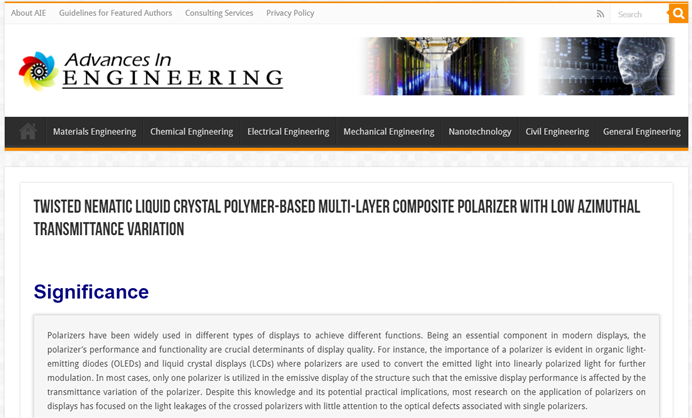Recently, a paper published in Optics Express (Volume 29, 20 December 2021, page 43720-43730) by Dr. Chi Zhang in the Yubao Sun' group of School of Sciences is selected as key scientific paper by Advances in Engineering (AIE), and on 6th April, 'Twisted nematic liquid crystal polymer-based multi-layer composite polarizer with low azimuthal transmittance variation' was featured. The research was supported by the National Key Research and Development Program of China and the National Natural Science Foundation of China.

Polarizer have been widely used in different types of displays, and its performance and functionality are crucial determinants of display quality. For instance, the importance of a polarizer is evident in organic light-emitting diodes (OLEDs) and liquid crystal displays (LCDs). The iodine type polarizer, whose polarization selecting effects is based on the alignment of the iodine molecules, is the most used in displays. Due to its anisotropic structure, it exhibits obvious azimuthal transmittance variation. This transmittance variation is generally difficult to eliminate, considering the emissive displays only have one polarizer, it is important to prevent or minimize the azimuthal transmittance variation to improve display quality. On this account, Dr. Chi Zhang and Prof. Yubao Sun developed a multi-layer composite polarizer with a twisted nematic liquid crystal polymer (TN-LCP) polarizing layer structure. The research results show that the azimuthal transmittance variation of the multi-layer composite polarizer is smaller (about on-fifth) compared with that of the normal polarizer. Further calculations shows that the ability to adjust/tune the transmittance distribution of the composite polarizer to achieve various specific application requirements. The concerns regarding color shift and low transmittance of the composite polarizer are addressed by increasing liquid crystal polymer layer thickness and reducing the polarization degree of the polarizing layers. The iso-transmittance plots of single polarizer and the composite polarizer are shown in Fig.1. In summary, the multi-layer composite polarizer can reduce the azimuthal transmittance variation ratio below that of the normal polarizer.

Fig. 1 The iso-transmittance plots of (a) single polarizer, and (b) the composite polarizer
Advances in Engineering features papers of exceptional scientific importance and intelligible to a broad scientific audience. Emphasis is given to all aspects of Engineering. Papers featured in Advances in Engineering must be of high significance in any area of Chemical, Materials, Aerospace, Computer, Civil, Construction, Biomedical, Nanotechnology, Electrical and Mechanical Engineering. Featured papers are assessed primarily on their scientific validity and merit. Advances in Engineering is highly selective, the invited articles are less than 0.1% of the whole published literature (maximum 20 per week chosen by a team of advisers and experts).
The original link:
https://advanceseng.com/twisted-nematic-liquid-crystal-polymer-based-multi-layer-composite-polarizer-low-azimuthal-transmittance-variation/